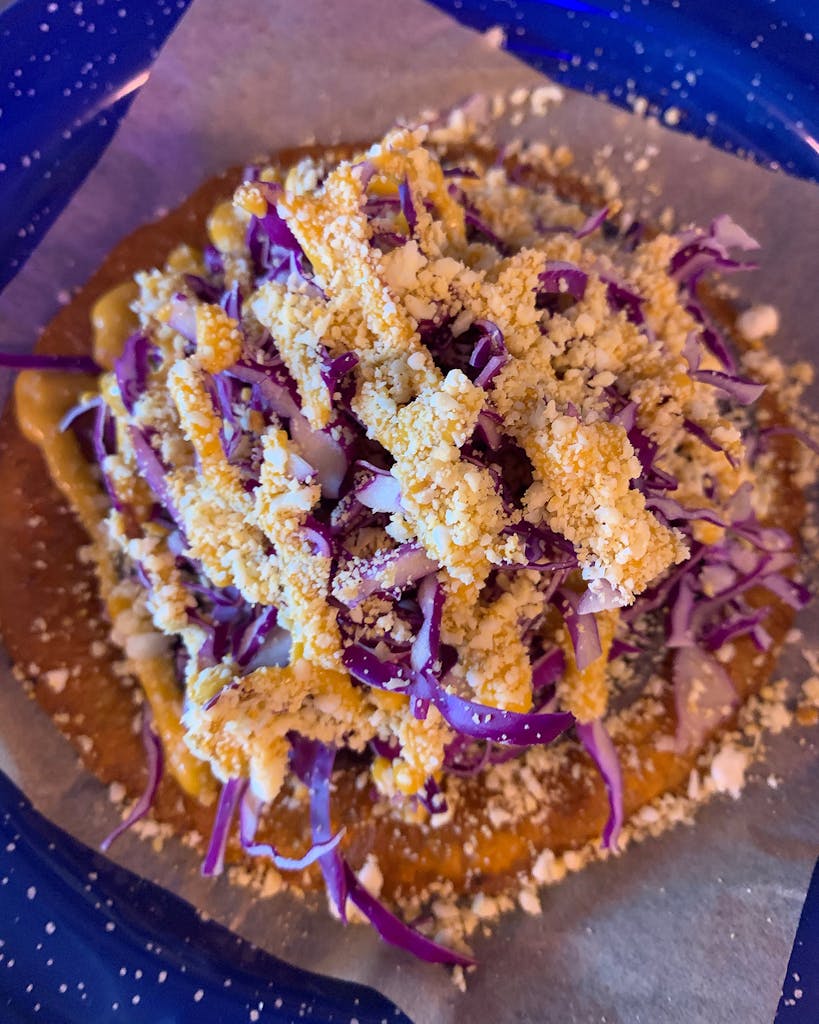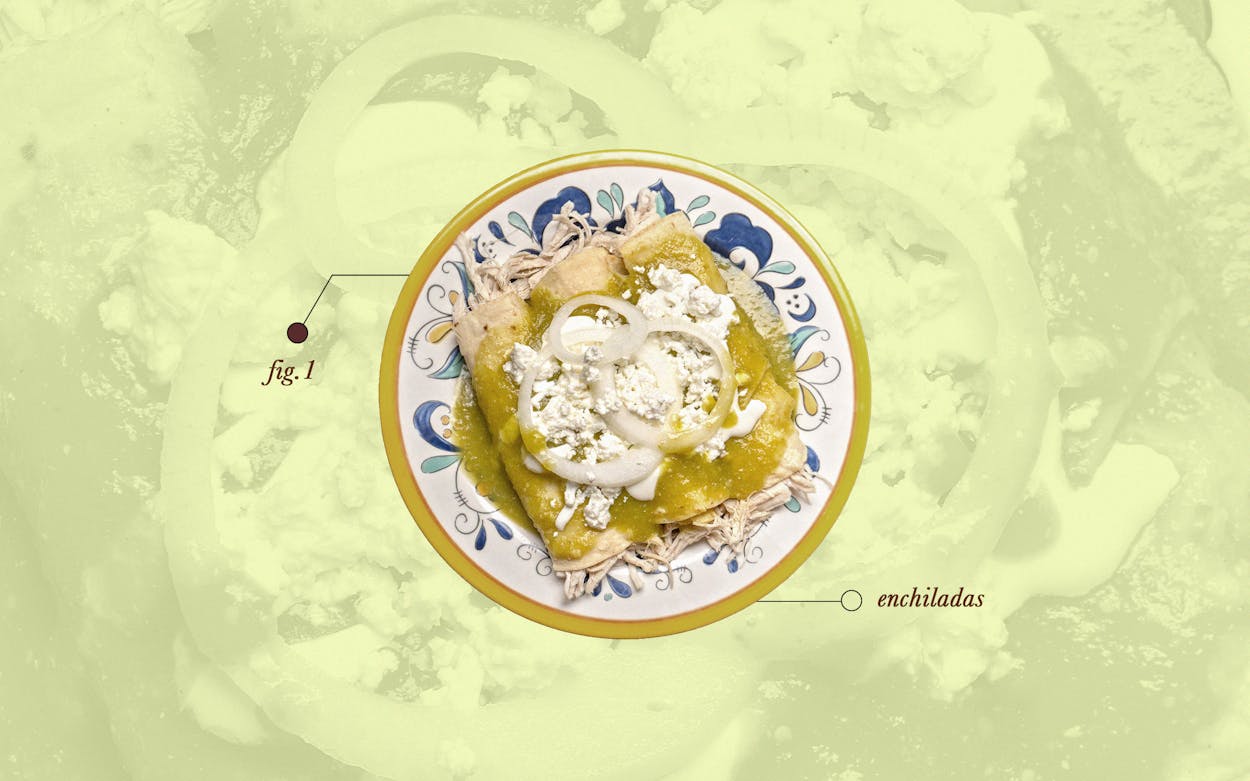The litmus test for any great Tex-Mex restaurant is its enchiladas plate. That usually means cheese enchiladas drowned in chili con carne, also called chili gravy—but there are dozens of equally delicious, lesser-known varieties. The best enchiladas I’ve ever tasted didn’t contain cheese. A friend and I were driving the length of the Texas-Mexico border just before Christmas 2019, and we stopped at Mando’s Restaurant in Marfa for dinner. I was blown away by the deep flavor of the shredded chicken enchiladas, which were soaked in a woodsy guajillo chile sauce. They were so great, I didn’t want to share them. To my dismay, the owner told me that the restaurant would soon cease operations; she was also mum on the details of the recipe. But I still measure a Texas Mexican restaurant by those enchiladas. They remind me that there are myriad interpretations of the dish, each with its own regional flavor and history to explore.
Take, for example, the enchiladas mineras at Torres Mochas in Paris, lightly topped with perfectly cooked carrots and potatoes. The dish earned its name because it was a common meal of workers who stripped the mines of Guanajuato. Another example is the enchiladas suizas (Swiss enchiladas), invented at the Mexico City department store chain Sanborns in 1950. That dish—rolled, chicken-stuffed tortillas broiled in a bath of serrano-tomatillo sauce, cream, and melted white cheese—is a staple on both sides of the border.
For El Naranjo chef and co-owner Iliana de la Vega, enchiladas are a beloved dish. One of her many favorites doesn’t even have “enchilada” in its name: de la Vega loves enfrijoladas oaxaqueñas. While “enchilada” means soaked, rubbed, or dipped in chile sauce, “enfrijolada” refers to doing the same with bean sauce. With enfrijoladas oaxaqueñas, the tortillas are covered in a black bean sauce flavored with pasilla de Oaxaca chiles and avocado leaves. “The stuffing is not important. I like them just folded with lots of crema mexicana and queso fresco,” she says. (She is also a big fan of enmoladas, which are rolled tortillas soaked in mole.)
Whatever sauce you choose, enchiladas do have a few key features. The sauce must rely on chiles, and the tortillas should be passed through the salsa either before or after getting a light fry to soften them. “There are exceptions in which the masa is mixed with a chile paste and then filled,” says de la Vega. “Those are normally not bathed with a sauce.”
One example is the brilliant enchilada potosina taco at Nixta Taqueria, where the masa for the nixtamalized corn tortillas is blended with chile guajillo paste before pressing. The dish’s shimmering red base and fillings are capped with queso enchilada, an aged cheese whose rind is rubbed with chiles. Traditional Mexican enchiladas are usually finished with Mexican crema and queso fresco or cotija cheese, instead of the yellow cheese typical of Tex-Mex enchiladas. Edgar Rico, chef and co-owner of Nixta Taqueria in Austin, is a fan of both styles. During a visit to Matt’s El Rancho, he remembers trying some of the Austin Tex-Mex institution’s enchiladas and feeling inspired to put his modernist Mexican spin on them. He set out to make cheese enchiladas with chili gravy and an upscale Mexican touch. The Nixta kitchen used its house-made nixtamalized blue corn tortillas. In place of chili con carne’s ground beef, the taqueria used local veal. The filling was a light mixture of Monterey Jack and cheddar. The enchiladas were dazzling (though unfortunately, as a temporary special, they’re no longer on the menu).

The word “enchilada” is likely derived from the Nahuatl word chīllapīzzali (chile flute). Bernal Díaz del Castillo described the dish in his 1576 Historia verdadera de la conquista de la Nueva España, which is where we first get a glimpse of the familiar rolled shape of the tortillas. Enchilada recipes later appeared in 1831 in El cocinero mexicano (The Mexican Chef), considered to be the cookbook that set the foundations of Mexican gastronomy.
It would take longer for white Americans to warm up to the enchilada. In the 1892 Through the Land of the Aztecs travelogue, a white tourist described the enchilada as a “greasy tortilla sandwich containing ‘chiles,’ and a number of other uninviting-looking compounds and other nasty messes . . . filling the air with a pungent, nauseous smell.” After denigrating Mexicans as natural, professional beggars and Mexican children as “barefooted,” “beautiful,” and, in a creepy clause, “usually clad in little else beside their pulchritude,” the 1909 San Antonio: Historical and Modern tourism guide goes on to describe the city’s famed chili stands near the Alamo. Among the many dishes served by the street vendors there were chili con carne and enchiladas. Their fellow Mexicans, Mexican Americans, and eventually Texans gobbled it up.
Over the decades, enchiladas became a cornerstone of Texas cuisine. Perhaps nowhere else in the state is that more apparent than at Sylvia’s Enchilada Kitchen in Houston. Established in 1999 by Brownsville native, food scientist, and chef Sylvia “Enchilada Queen” Casares, the eponymous restaurant offers a road map to the variety of the dish. The culinary cartography reminds us that Mexican foods are always tied to specific times, places, flavors, and memories to be honored—even if political borders exist where once there were none. Sylvia’s understands that. Its menu is separated into north-of-the-border and south-of-the-border sections, and each platter is named after a city. The classic Tex-Mex cheese enchiladas, smothered in chili gravy, are loaded with pure comfort. The dish takes its name from Refugio, a small town about an hour north of Corpus Christi. In fact, most of the American enchiladas at Sylvia’s are named after South Texas burgs. Many are blanketed in chili gravy. In conversation, Casares always goes back to the iconic Texas enchiladas she ate as a kid in Brownsville. “Growing up, sometimes after church, we would go to this restaurant, I guess you could call it a Tex-Mex place, and I would get the cheese enchiladas plate. That’s how it all started,” she says.

If you want to expand your enchilada palate, Sylvia’s is a great place to start. The Crystal City platter is composed of spinach enchiladas bathed in a tomatillo salsa. Casares says it’s an homage to the town’s self-proclaimed status as the Spinach Capital of the World. The Sarita—which is also Casares’s great-grandmother’s name—is served up as rolled squash-and-corn enchiladas with a light cream sauce. Meanwhile, the Lubbock is a hearty dish of ground-beef enchiladas topped with a meatier, richer West Texas–style chili gravy. The El Paso platter consists of stacked enchiladas, a nod to the Sun City’s proximity to New Mexico and that state’s favored enchilada presentation.
The Mexican side of the menu is a list of must-visit cities; most of the enchiladas are paired with elements indicative of their namesake places. The Puebla platter is chicken enchiladas under mole. The Chihuahua enchiladas are filled with cheese, chicken, or ground beef, then slathered in a tomato-based salsa ranchera, a conflagration of spice. “The art is not the filling—the filling can certainly add to it—but you can create magic with an amazing sauce,” Casares says.
From there, perhaps you’ll be hungry for rarer, more regionally specific dishes, such as the orangey-stained enchiladas placeras from Morelia, Michoacán, folded and sealed before being deep-fried. Perhaps you’ll come across one of de la Vega’s favorite enchiladas, a preparation stuffed with spinach, almonds, raisins, and goat cheese submerged in a tomato-chipotle sauce and garnished with crema and queso fresco. Perhaps you’ll dig into enchiladas de leche, which come dressed in a sauce of mulato chiles, ancho chiles, milk (leche), and eggs. The tortillas are soaked in the mixture before frying in lard. They are adorned with shredded lettuce and cheese. Like the taco, the whole enchilada is practically endless in variations. As Rico says, “It’s cool to see what you can do with just sauce and a tortilla, depending on what you want to fill it with. The sky’s the limit.”
- More About:
- Tex-Mexplainer
- Paris
- Houston
- Austin








